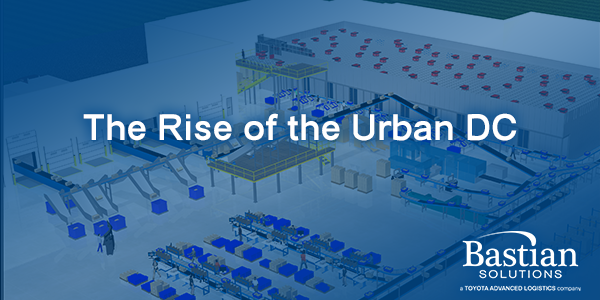
The Rise of the Urban DC
Jeff Snyder | 23 April 2019
More and more people, especially young adults, are moving into cities. To reach this increasingly important market segment, retailers need to find a profitable and efficient way to do urban fulfillment.
Omnichannel and e-commerce fulfillment is projected to eclipse $528 billion in 2018. Consumers are increasingly demanding the ability to place orders through any channel and receive the items when and where they want. Retailers are grappling with this revolution while facing a significant demographic change that complicates order delivery and fulfillment. These new urban markets provide fertile prospects for omnichannel retailing. Fulfilling small volume, high frequency omnichannel orders in an urban setting adds complications not seen in a suburban or rural fulfillment environment.
In a recent Annual State of Retail Supply Chain Report, 60% of respondents said they are active in urban fulfillment, with 80% saying that interest in urban fulfillment is increasing and 78% said the pursuit of the metro DC outweighs the costs. Winning the battle for city shoppers will not be easy. Retailers must establish networks with the capabilities to fill and deliver product to urban customers quickly and efficiently. To deliver in an urban environment, retailers must consider five factors:
| 1. Fulfillment from store |
86%* |
| 2. Fulfillment from retailers regional DC |
83%* |
| 3. Click and collect from store |
77%* |
| 4. Fulfill from vendor D |
44%* |
| 5. Fulfill from 3PL DC |
26%* |
*Some retailers use more than one method.
While the first three are universal omnichannel challenges, the last two are more critical for the urban fulfillment model. Two-day, next-day, and even same-day deliveries have become the standard for e-commerce, and customers are increasingly demanding the same standard of omnichannel. The good news is that faster delivery is achievable in an urban market, thanks to the population density and proximity to customers.
The challenge, however, then becomes inventory availability. Unlike suburban areas which can rely on regional fulfillment centers and large stores, urban omnichannel runs up against capacity constraints at every turn, due to the limited capacity for inventory in urban areas. The most common fulfillment methods are:
| 1. Click and collect |
76% |
| 2. Fulfill from store |
56% |
| 3. Fulfill from regional DC |
27% |
Three emerging solutions for innovative omnichannel fulfillment include dark store fulfillment, multi-tenant facilities and pop up fulfillment centers.
Dark Stores are retail outlets with no walk-in customer traffic, and while they are popular in Europe, they are not in the U.S. In dark stores, order pickers use multi bin carts and a tablet computer to navigate the store while efficiently filling orders. Completed orders are packed for final delivery to the customer’s homes, offices or lockers. Advantages include rapid order fulfillment, reduced aisle congestion and limited stockouts. Another advantage is repurposing existing stores to this model rather than completely closing.
Multi-Tenant fulfillment centers allow retailers to access capacity in urban markets that have low vacancy rates. These shared e-commerce providers, typically run by 3PL’s, offer space flexibility, market proximity and variable cost operations. The future goal is to create shared inventory pools to support multiple fulfillment needs across multiple retail tenants.
Pop Ups are a short-term approach to urban fulfillment. These operations are typically located in empty malls or unused warehouses and are used to help maintain service quality during peak or holiday seasons. To be successful, pop ups require proximity to the customer, allowing next-day delivery, availability and flexibility of a scalable workforce and connectivity to the retailer’s WMS. Typically, pop ups warehouse the top 1,000 SKUs, or “A movers.”
To succeed in omnichannel urban fulfillment, like our recent success with Best Buy, retailers must deploy the right combination of resources, processes and technologies. A key consideration is establishing fulfillment types and then aligning the properties and infrastructure to match the order profiles and demand patterns.
In the end, speed and convenience will be critical to winning over the urban e-shopper. Right now, most retailers are relying on their existing supply chain footprint, however, as urban demand continues to rise, successful retailers will be the ones that can build and develop these urban capabilities.
Jeff Snyder is a Senior Consulting Engineer with Bastian Solutions. He has over 25 years of operations and engineering management experience, working with industries including retail, ecommerce, food and beverage, parts distribution and reverse logistics. He is a strong proponent of using data analysis and modeling to derive fact-based concepts and designs. He earned his B.S. in Industrial Engineering from Texas Tech University.
Comments
No comments have been posted to this Blog Post
Leave a Reply
Your email address will not be published.
Comment
Thank you for your comment.